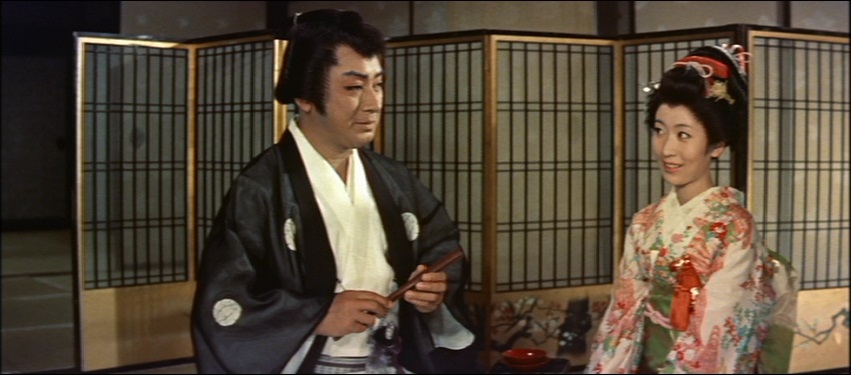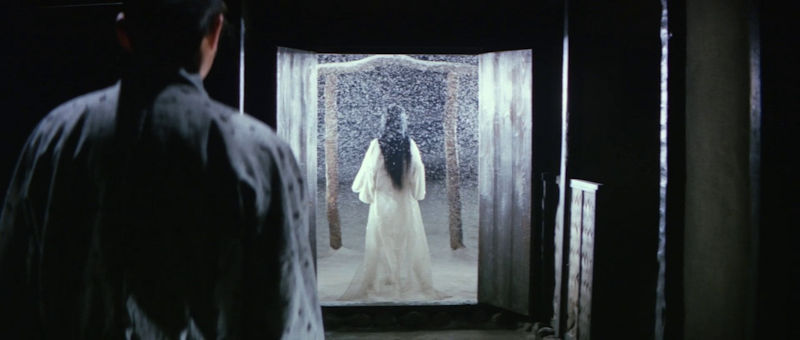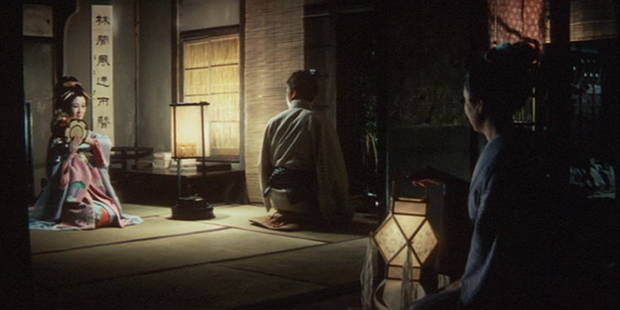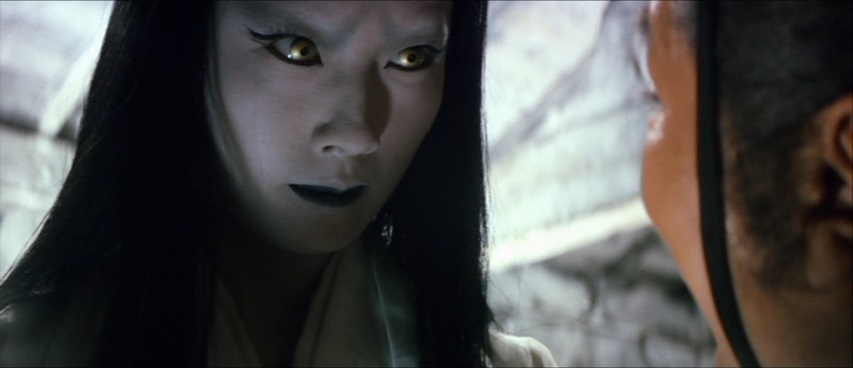
Written by Richard Durrance on 11 Oct 2024
Distributor Radiance • Certificate 15 • Price £44.99
Could it be Halloween again? Considering Radiance have four films with a spooky flavour all coming out in the same month it may just be. This set of gothic films from the defunct Daiei studio contains three of these ghostly films to be released and all are new to me. What better then to explore something unknown, exciting and supernatural?
The Ghost of Yotsuya (Kenji Misumi, 1959)
Ronin Lemon (Kazuo Hasegawa) lives in poverty with his wife, Oiwa (Yasuko Nakada), in a marriage that was a love match. Unable to find work, he fishes, drinks, and after failing to find employment with Lord Ito accidentally saves Ito's daughter Oume (Yoko Uraji) from attackers. What else can Oume do than fall for her saviour? Lord Ito, being the doting father, conspires to ensure Lemon will marry Oume through any means possible.
The Snow Woman (Tokuzo Tanaka, 1968)
A sculptor and his adopted son and protege, Yosaku (Akira Ishihama), take refuge from a storm, only to encounter the Snow Woman, who must kill all who see her. Having taken the life of the elder man she allows the younger one to go free should he promise never to speak of what happened there again. Weeks later and Yuki (Shiho Fujimura) is invited into Yosaku’s home and becomes his wife. Yosaku is tasked by the local priest to carve a statue of Kannon for the temple, something that Lord Jito wishes to use to his advantages as his lustful eyes catch sight of the pale, beautiful Yuki, who may not be all she seems.
The Bride from Hades (Satsuo Yamamoto, 1968)
Refusing to marry the bride of his dead brother despite the prestige it will bring his family, Shinzaburo (Kojiro Hongo) prefers to live among people in the town, where he teaches the local children. Taking the children to the Obon festival he meets a courtesan, Otsuyu (Miyoko Akaza), and her companion, Oyone (Michiko Otsuka). Shinzaburo falls in love with Otsuyu and she him, not realising she is a spirit awaiting to the end of the festival until she can leave this world.

The Ghost of Yotsuya
Horror as tragedy and vengeance is very much how The Ghost of Yotsuya plays out. This is one of two versions of the story made in the same year and is clearly a production of some value, well shot in the studio, in colour, and lovely looking to boot; it’s no second feature and is graced in the lead role by the presence of prolific actor and star of Kon Ichikawa’s An Actor’s Revenge, Kazuo Hasegawa.
At 83-minutes it is relatively brisk even if perhaps it takes a while before the more ghoulish aspects appear, as the first half of the film is a drama that builds up to the latter moments of hauntings. A lot takes place in the build-up and all the various character relationships within the story could almost fill a police-board, with string connecting all the various suspects in a crime. The analogy is not entirely inappropriate as the narrative, though it includes pure souls such as Oiwa’s sister and her fiancé and even Oiwa herself, almost everyone else is complicit, corrupt or perhaps in the case of Iemon himself, disillusioned, disappointed, lazy and you suspect no longer in love with his wife. Not that he is in love with Oume either, rather willing to be blown about by the winds of change, a samurai without purpose and so as his wife is poisoned and turns into a tragic, disfigured entity he is in no way equipped to empathise or understand but only lash out violently.
The ending is traditional, this is ghost story after all, our villains requiring their comeuppance and this is stylishly done with those needing the hand of vengeance momentarily taking on the appearance of Oiwa in her diseased, deathly state and causing that person to feel the vengeance of her spirit. There is the possible argument that this could be both spiritual, supernatural but also a manifestation of guilt. Much of the vengeance is accidentally meted out by Iemon and it could be considered that his guilt at his casually dismissive behaviour towards his wife is as much the cause of what we see as her spirit returning. After all, even in those nights where he is away from home, at Lord Ito’s, he does not necessarily want to be there beyond the free food and sake; does he love Oume? He may be attracted to her but love, it seems unlikely as at best she is callow, at worst a spoiled fool who seems more interested in being the melodramatic lover than an actual loving person.
The denouement as mentioned is stylishly done and impressive. There’s one great scene at the river where Iemon finds his dead wide’s hair in the river, and he pulls and pulls and it keeps coming, and coming, in unnatural lengths, stickily, darkly churning out from the viscous water. This final haunting doesn’t hang about, it's concise and emotionally effective, though throughout the story there is perhaps that problem common to supernatural tales, which is where our sympathy lies, e.g. who are we meant to care about, especially considering we know Oiwa will die. These roles are filled by her sister and her fiancé, and the loyal servant, who loves Oiwa, and their humanity is needed to balance out the venal, self-interest of most everyone else we meet.

The Snow Woman
It would be easy to see this version of the story from Lafcadio Hearn's collection of ghost stories as being a poor relation to the segment filmed in Masaki Kobayashi’s 1964 Kwaidan, but that would be a disservice to what is a quietly wonderful film. Just shy of 80-minutes, it need not be a moment longer even though this is an extended version of the story. It is elegantly, often beautifully filmed, and almost perfectly paced. Whereas you could suggest that the first half of The Ghost of Yotsuya is perhaps a little drawn out, here the pacing never seems to flag or alternatively to hurry itself up. Part of what matters here is that the supernatural elements of the story are introduced immediately and float throughout the film, sometimes coming to the fore but often lingering in the background, an ominous shadow. True, often the more supernatural aspects are those that are the most beautiful, but the visuals are consistently elegant, often quietly gorgeous throughout. It is not a film where the more dramatic elements are any less interesting, even if the greatest visual motifs and moments are certainly those of hauntings and death. The Snow Woman with her golden eyes, looking askance at her victims, with her face a pale mask, are delicious, gorgeously shot and arguably wonderfully performed for how there is no attempt to obviously perform, this is a mask after all, a cold, chill face of death approaching, inescapable and implacable. But there is not an implacable heart behind it, quite the opposite, for the feeling that is there, for the desire for love, a child and a normal life exists within the Snow Woman, Yuki.
If I use words like elegant and quiet a lot here it is because those seem the most overriding adjectives, as this is the most elegant of ghost stories, and visually it’s a treat throughout. Snow falling is easily made beautiful but the scenes, for instance, where Yuki saves the local governor’s child are filmed so that nature and the internal workings of the building merge in a delicious series of images. In truth the film is filled with images that could be framed and placed on the wall, one after the other after the other. When I say quiet it is because though we have lustful bastards like Lord Jito who will happily do anything to try and get Yuki’s body, he is the exception and the emotions of our characters quietly roil under the surface. Equally for all their beauty and colour often these are subtly muted and their quiet gentleness exploits their inherent loveliness over how bright, bold colours might. This is a muted world, and when we do see something that is gold, as we find out, it is soulless.
Add to this the ethereal score by Akira Ifukube, which is beautifully crafted. Whereas his score for Godzilla is a bold march – which is brilliant in the context of that film – here it underscores all we see, heightening the mood. It shows Ifukube’s flexibility and understanding of scoring. Godzilla needs a stomping score, whereas The Snow Woman needs something more enthralling and ethereal.
What is fascinating about The Snow Woman is that in many ways the story is still very standard. And so it’s for the filmmakers and the performers to carve from it, to chisel something wonderful and the eventual film is a joy. It’s one where several images will seer into the mind (there’s a reason why an image from it is being used on the cover to the boxset, it’s a stunner amongst stunners) but it’s a film where all the various aspects coalesce and turn into the most softly intoxicating type of ghost story, one which is not about jump scares but more importantly at its heart it is a film and a story with a heart, because it is more than anything else a love story, and so we can always relate to it at on the most straightforward emotional level and then on the supernatural; it is the kind that seduces visually.
And why not, Yosaku is seduced by Yuki, and we by the film.

The Bride from Hades (Satsuo Yamamoto, 1968)
Doing some very brief reading into the story, as with the other films in the set, this tale has been filmed numerous times, including a Nikkatsu Roman Porno (which as you watch it you can understand how this could be very possible), but this, like The Snow Woman, is a carefully paced, often subtly coloured film, with precise attention to sound and image. At 90-minutes it’s the longest film in the set (if hardly long by modern standards) but again this works in the favour of the film, as it means it is not dragged out, which it could easily have been. All three films make you realise why a film like Kwaidan works, because ghost stories are short in the main, to the point and they don’t necessarily have the legs for a longer narrative - they must play out naturally.
The Bride from Hades takes some time to set up the story and Shinzaburo as a character, his background and his passions: he describes himself as a bookworm without much knowledge of the sensual world. That he devotes time to the children of the poor is noble and touched on lightly and with humour. Essentially, Shinzaburo is a good person and finds love for the first time. He’s tolerant too of his employee, Banzo (Ko Nishimura, he of the recent Fukasaku release The Threat), a drunk who often shows genuine compassion for Shinzaburo when he realises what is occurring, how this woman that he is falling for is a ghost, and literally sucking the life from him.
Arguably, this makes the narrative slightly troublesome, because though you have a love story where you want these two people to be happy, even if Otsuyu is a corpse, Shinzaburo’s impact on the community is such that his loss may potentially impact the quality of life of dozens of children. It’s a dilemma and, oddly perhaps, Shinzaburo is quite a passive character, Otsuyu and her undead chaperone’s desire to have them unite in love and death if anything is what moves the narrative, that and Banzo’s awful, manipulative, venal wife, Omine (Mayumi Ogawa). There’s also the local priest, played by the great Takashi Shimura, who fights to protect Shinzaburo, even if you know it will never quite work.
That said how the story is portrayed visually is often gorgeous and though if described much of this seems rote that is because it’s standard descriptions of the undead, the floating bodies, the gliding through spaces, but the realisation of this on screen has a precise, floating unreality that then gently merges with the real, the corporeal, so that you can see why Shinzaburo may be lost between love and horror at recognising this woman he has found and loves is dead.
If there’s a problem with the story it is the age-old locked door issue. Priests from the temple place wards across Shinzaburo’s doors, to protect him in those last days of the festival before the two women must leave, and this is where Omine, Banzo’s wife, suddenly appears. She is an absolute shrew, a vicious harridan who will exploit anything for her own good, and tonally it felt a bit out of place with the rest of the story. Banzo is already a little this way, self-centred but more human; yes, he is using Shinzaburo as a cash cow, but he also cares enough about him, whereas Omine is just an awful human being and the story you can argue needed a more elegant way to bring the two lovers together than her self-centred intervention.
But because the realisation is so good, including how when the two dead women speak their voices subtly echo, and how their bodies often age on screen, how Shinzaburo seems to pale and grow ill before our eyes we can forgive these misdemeanors, even if the film never quite reaches the heights of The Snow Woman. Then again, The Snow Woman is special.

This is not a set for fans of blood and guts, but one for those that appreciate an elegant story, beautifully realised on screen, with ethereal presences making themselves known. There’s often a depth of focus on character, right from the first film I watched in The Ghost of Yotsuya. It makes sense, as these are films of subtle horror, of unease, rather than the overt and visceral. Arguably films like this are harder to get right because they are at heart dramas, and they must engage us emotionally as well as visually; they haven’t a more overt horror trapping to fall back on that might mollify an audience. The end result is a superb set of beautifully crafted films, but it’s star for me – as if you didn’t already know – is The Snow Woman, a real thing of beauty, and a wonderful discovery.

Long-time anime dilettante and general lover of cinema. Obsessive re-watcher of 'stuff'. Has issues with dubs. Will go off on tangents about other things that no one else cares about but is sadly passionate about. (Also, parentheses come as standard.) Looks curiously like Jo Shishido, hamster cheeks and all.
posted by Richard Durrance on 17 Dec 2025
posted by Richard Durrance on 12 Dec 2025
posted by Ross Locksley on 09 Dec 2025
posted by Richard Durrance on 28 Nov 2025
posted by Richard Durrance on 25 Nov 2025
posted by Richard Durrance on 18 Nov 2025
posted by Richard Durrance on 14 Nov 2025
posted by Richard Durrance on 11 Nov 2025